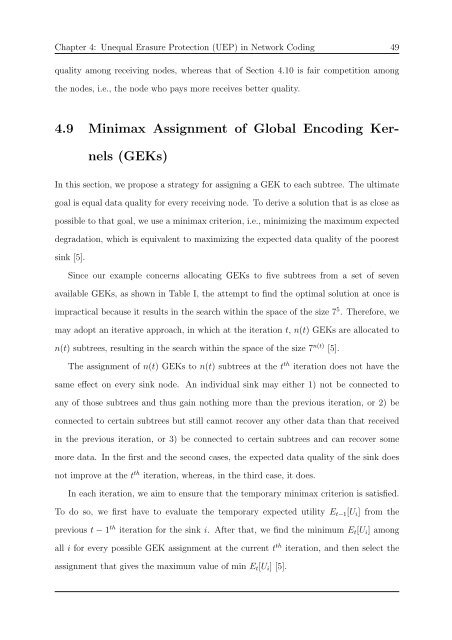Network Coding and Wireless Physical-layer ... - Jacobs University
Network Coding and Wireless Physical-layer ... - Jacobs University
Network Coding and Wireless Physical-layer ... - Jacobs University
You also want an ePaper? Increase the reach of your titles
YUMPU automatically turns print PDFs into web optimized ePapers that Google loves.
Chapter 4: Unequal Erasure Protection (UEP) in <strong>Network</strong> <strong>Coding</strong> 49<br />
quality among receiving nodes, whereas that of Section 4.10 is fair competition among<br />
the nodes, i.e., the node who pays more receives better quality.<br />
4.9 Minimax Assignment of Global Encoding Kernels<br />
(GEKs)<br />
In this section, we propose a strategy for assigning a GEK to each subtree. The ultimate<br />
goal is equal data quality for every receiving node. To derive a solution that is as close as<br />
possible to that goal, we use a minimax criterion, i.e., minimizing the maximum expected<br />
degradation, which is equivalent to maximizing the expected data quality of the poorest<br />
sink [5].<br />
Since our example concerns allocating GEKs to five subtrees from a set of seven<br />
available GEKs, as shown in Table I, the attempt to find the optimal solution at once is<br />
impractical because it results in the search within the space of the size 7 5 . Therefore, we<br />
may adopt an iterative approach, in which at the iteration t, n(t) GEKs are allocated to<br />
n(t) subtrees, resulting in the search within the space of the size 7 n(t) [5].<br />
The assignment of n(t) GEKs to n(t) subtrees at the t th iteration does not have the<br />
same effect on every sink node. An individual sink may either 1) not be connected to<br />
any of those subtrees <strong>and</strong> thus gain nothing more than the previous iteration, or 2) be<br />
connected to certain subtrees but still cannot recover any other data than that received<br />
in the previous iteration, or 3) be connected to certain subtrees <strong>and</strong> can recover some<br />
more data. In the first <strong>and</strong> the second cases, the expected data quality of the sink does<br />
not improve at the t th iteration, whereas, in the third case, it does.<br />
In each iteration, we aim to ensure that the temporary minimax criterion is satisfied.<br />
To do so, we first have to evaluate the temporary expected utility E t−1 [U i ] from the<br />
previous t − 1 th iteration for the sink i. After that, we find the minimum E t [U i ] among<br />
all i for every possible GEK assignment at the current t th iteration, <strong>and</strong> then select the<br />
assignment that gives the maximum value of min E t [U i ] [5].

















